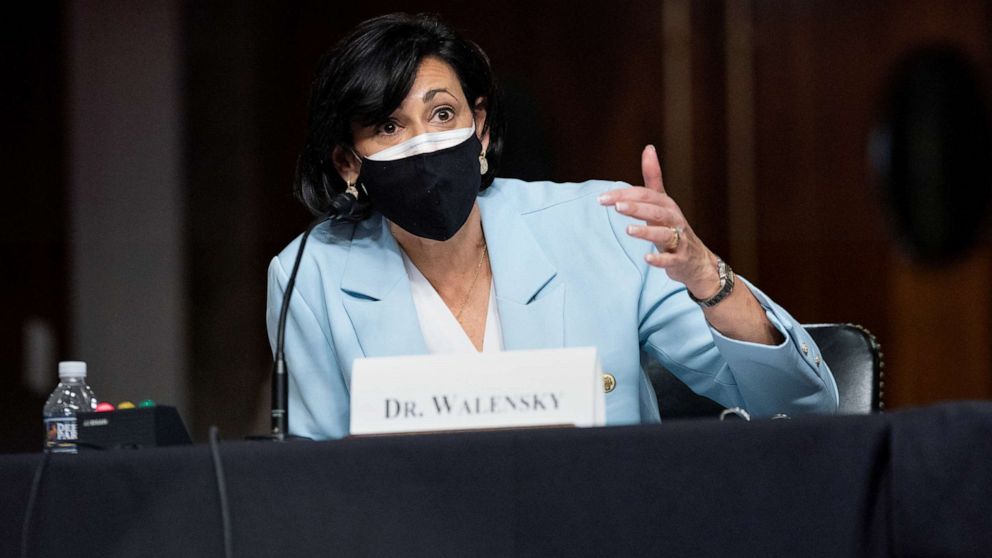白宫开始组装一个流行病最近几周的国家退出战略,召集卫生专家和助手制定了一项被一名高级官员描述为“保持国家前进”的计划。
但是拜登政府的高层推动在本周被一群民主党州长抢先了一步渴望取消限制周三,疾病控制和预防中心和白宫对此进行了温和的抵制。
白宫新闻秘书珍·普萨基(Jen Psaki)周三对记者表示:“我们继续直接向州长传达我们的建议,即他们遵守联邦公共卫生指南,但我们也理解,他们可能会根据自己认为对社区最有利的情况做出决定。
与此同时,白宫表示,它理解人们对口罩感到厌倦。
“我们当然理解灵活的必要性,”普萨基说。
在遵循公共卫生机构的指导数月后,几名民主党州长本周宣布了取消学校和其他地方口罩禁令的计划。六个州——加州、特拉华州、伊利诺伊州、纽约州、俄勒冈州和罗德岛州——表示,他们将在未来几周内取消通用口罩的规定,这意味着人们将不会被要求在室内公共场所佩戴口罩。
说到学校,马萨诸塞州、罗德岛州、新泽西州、特拉华州、康涅狄格州和俄勒冈州将在未来几周内停止要求戴口罩,由各个学区决定学生是否应该戴口罩。
这些举措与疾控中心的建议不一致,疾控中心建议每个2岁及以上的人都应该继续在室内公共场所戴口罩。

格雷格·纳什/路透泳池
疾病控制和预防中心主任罗谢尔·瓦伦斯基博士回答了问题..
疾控中心主任罗谢尔·瓦伦斯基周三告诉记者,疾控中心正在更新其指南。但她拒绝透露该计划将包括哪些内容,比如具体的基准,这些基准可能会被用来帮助那些已经取得进展的州。
瓦伦斯基说:“我们当然会实时密切关注这一点,我们正在评估传播率,以及严重后果的发生率,同时考虑更新和审查我们的指南。
“但我要说的是,你知道,我们的住院率仍然很高,死亡率仍然很高,所以当我们努力实现这一目标时,当我们受到当前趋势的鼓舞时,我们还没有达到目标。”
这种方法让疾控中心在很大程度上处于观察状态,既不规划国家前进的道路,也不谴责那些自己这样做的州,而是继续监测数据。
这条线很细,对一些人来说,很混乱。
瓦伦斯基说,疾控中心计划很快更新指南,为口罩的决策提供信息,但也认为决策应该在地方一级做出。
尽管疾控中心目前仍在推荐口罩,但瓦伦斯基表示,这一立场并不是对计划在未来几周取消口罩授权的州的谴责,届时病例、住院和死亡人数都可能会降低。
白宫支持疾控中心的立场,尽管它表示正在与卫生专家合作,制定一项计划,使国家走向正常。
“过去几周,我们一直与(卫生部长)泽维尔·韦塞拉密切合作,我们的医生团队和总统领导下的白宫COVID应对团队正在联系州长和外部公共卫生专家以及医生和当地公共卫生官员,讨论我们应该采取的措施,以保持国家向前发展,”白宫COVID协调员杰夫·齐恩斯周三说。
当被记者问及人们是否应该遵循他们的州长或疾控中心时,瓦伦斯基说,他们应该寻求当地的指导——但澄清说,这些决定中的许多在几周内无效,这为疾控中心的指导提供了机会。
“它们必须在地方一级进行,但我真的很受鼓舞,病例继续大幅下降。随着人们做出这些决定,以及我们正在制定指导方针,住院人数继续大幅下降。所以看到这些趋势我很受鼓舞,”瓦伦斯基说。
瓦伦斯基概述了疾控中心为改变指导方针而考虑的所有主要数据。
瓦伦斯基说:“在我们对监测的部分审查中,我们查看废水、病例、住院情况……我们查看死亡情况,当然这些决定是在地方一级做出的。
瓦伦斯基说,但目前,这些数据都没有表明美国应该取消口罩授权。
她说:“目前,我们继续建议在高传播和大量传播的地区,也就是现在美国的大部分地区,在公共室内环境中进行掩蔽。
Governors dropping mask mandates preempts White House efforts to 'move forward'
The White House began assembling apandemicexit strategy for the nation in recent weeks, pulling together health experts and aides to develop what one top official described as a plan "to keep the country moving forward."
But the top-level push by the Biden administration was preempted by a chorus of Democratic governors this weekeager to pull back restrictions, prompting gentle pushback Wednesday from the Centers for Disease Control and Prevention and the White House.
"We're continuing to convey directly to governors our recommendation that they abide by federal public health guidelines, but also our understanding that they may make decisions based on what they feel is best for their communities," White House press secretary Jen Psaki told reporters on Wednesday.
At the same, the White House said it understood people were tired of masks.
"We certainly understand the need to be flexible," Psaki said.
After months of following the guidance from public health agencies, several Democratic governors this week announced plans to lift mask mandates in schools and elsewhere. Six states — California, Delaware, Illinois, New York, Oregon, Rhode Island — have said they will drop their universal mask mandates in the next few weeks, meaning people will not be required to wear them in indoor public places.
When it comes to schools, Massachusetts, Rhode Island, New Jersey, Delaware, Connecticut, and Oregon will stop requiring masks in the next few weeks, leaving it up to individual school districts to decide if students should wear them or not.
The moves are at odds with the CDC recommendation that everyone ages 2 and older should continue to wear a mask in indoor public settings.
CDC Director Rochelle Walensky told reporters Wednesday that the CDC was working on updating its guidelines. But she declined to say what it would include, like specific benchmarks that might be used to help inform states that are already forging ahead.
"We're of course taking a close look at this in real time and we're evaluating rates of transmission, as well as rates of severe outcomes, as we look at updating and reviewing our guidance," Walensky said.
"What I will say though is, you know, our hospitalizations are still high, our death rates are still high, so as we work towards that and as we are encouraged by the current trends, we are not there yet."
The approach leaves the CDC in a largely observational state, neither charting a national path forward or denouncing states that do so on their own, but continuing to monitor data.
It's a fine line, and for some, confusing.
Walensky said the CDC plans to update guidance to inform decision-making on masks soon, but also that decisions should be made at a local level.
And while the CDC is still recommending masks right now, Walensky said that position wasn't a denouncement of states who are planning to lift their mask mandates in the next few weeks, when cases, hospitalizations and deaths are all likely to be lower.
The White House backed the CDC position, even as it said it was working with health experts for a plan to move the country toward normalcy.
"For the last several weeks, we've been working closely with (Health Secretary Xavier) Becerra, our team of doctors and the White House COVID response team under the President's leadership is reaching out to Governor's and outside public health experts and doctors and local public health officials on steps we should be taking to keep the country moving forward," White House COVID coordinator Jeff Zients said Wednesday.
Asked by a reporter if people should follow their governors or the CDC, Walensky said they should be looking to their local guidance -- but clarified that many of these decisions aren't effective for weeks, leaving the door open for CDC's guidance to line up with it.
"They have to be done at the local level, but I'm really encouraged that cases are continuing to drop dramatically. Hospitalizations are continuing to drop dramatically as people are making these decisions and as we are working on our guidance. So I'm encouraged to see those trends," Walensky said.
Walensky outlined all the major data the CDC takes into account to change its guidance.
"In part of our review of the surveillance, we look at wastewater, we look at cases, we look at hospitalizations … we look at deaths, and of course those decisions are made at the local level," Walensky said.
But right now, none of that data indicates the U.S. should drop its mask mandates, Walensky said.
"At this time we continue to recommend masking in areas of high and substantial transmission, that's much of the country right now, in public indoor settings," she said.






